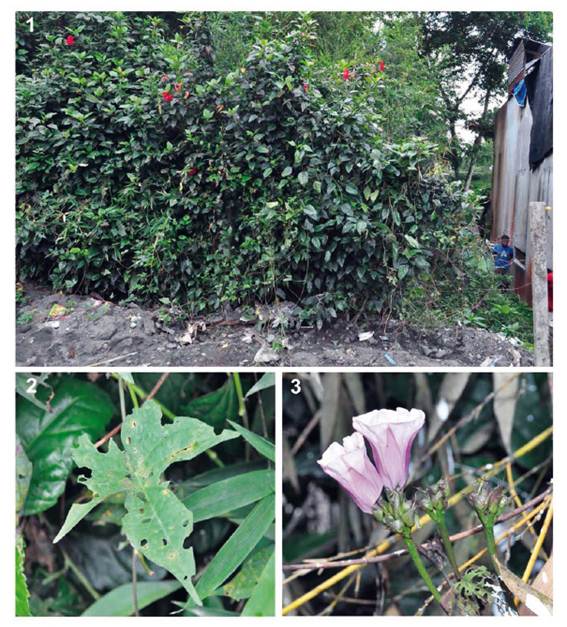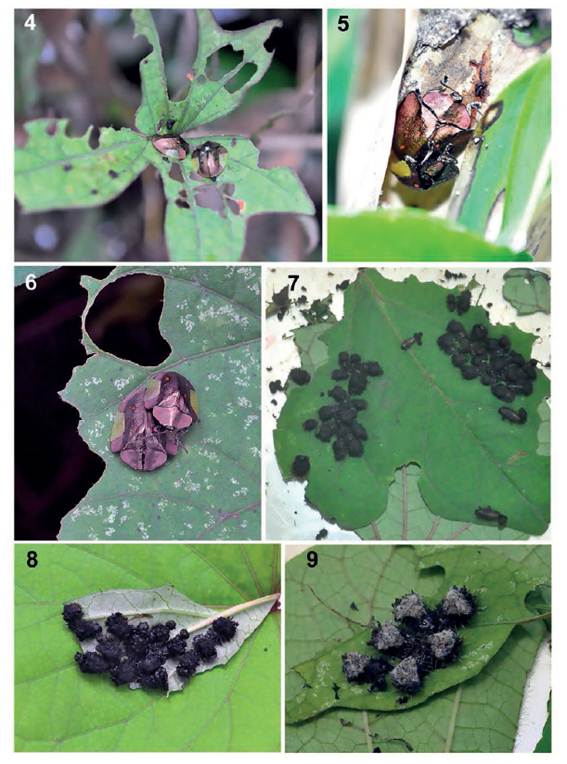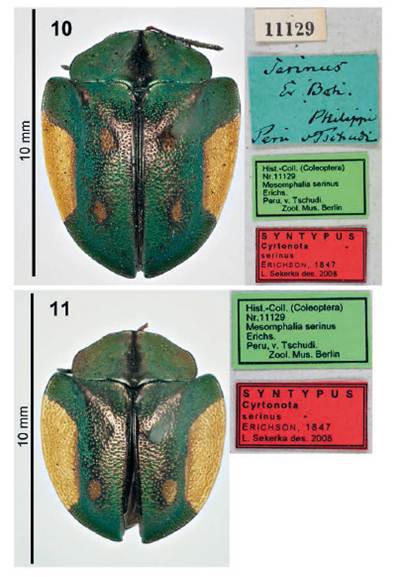Introduction
Cyrtonota Chevrolat, 1836 is a poorly-known genus comprising 64 species that are mainly South American and two species extend into Central America (Borowiec and Świętojańska 2012-2019). Hosts of Ipomoea L. spp. (Convolvulaceae) are documented for eight species (Marques 1932; Schlottfeld 1944; Silva et al. 1968). Biological information on juvenile stages is available for just three species (Świętojańska 2009) ‒limited details for Cyrtonota sexpustulata (Fabricius) (Marques 1932), and illustrated accounts for Cyrtonota thalassina (Boheman) (Buzzi 1988; Buzzi et al. 2000) and Cyrtonota lateralis (L.) (Świętojańska 2008).
Here we provide the first natural history notes for Cyrtonota sericinus (Erichson, 1847) based on observations of live populations in Ecuador. The species occurs in Argentina, Brazil, Bolivia, Colombia, Ecuador, and Peru. The adults show color polymorphism but little else is known about the species (Borowiec and Świętojańska 2012-2018).
Material and methods
The study is based on field observations of live populations (Figs. 1 - 9) led by the first author. The beetles were found on host plants in urban gardens at two sites:
ECUADOR: Prov. Pastaza, Puyo, 1°29'07.7"S, 77°59'51.8"W; elev. 950 m, 15.IV.2017, coll. P.E. Cedeño; Prov. Pastaza, Pto. Pitacocha, 1°18'32.6"S, 77°34'57.3"W, elev. 353 m, 3.IV.2017, coll. P.E. Cedeño.

Figures 1 - 3 Host plant of Crytonota sericinus (Erichson, 1847) in Ecuador (Photos: PE Cedeño). 1) Habitat with vining host plant growing in a mixed hedge. 2) Leaf with feeding damage. 3) Flower of the host plant.

Figures 4 - 9 Life cycle of Crytonota sericinus (Erichson, 1847) in Ecuador (Photos: PE Cedeño). 4 - 6) Adults show polymorphic color patterns. 7 - 9) Larval groups of different ages and sizes. Younger individuals (Figs. 7 - 8) with black exuvio-fecal shields. Older individuals (Fig. 9) with fungi growing in fecal shields.
Taxonomic identifications. The plant was identified as Ipomoea sp. (Convovluaceae) by Dr. David Alan Neill, Botany Department, Universidad Estatal Amazonica, Puyo, Ecuador. Beetles were identified from the adults by CSC in comparison with photographs of syntypes (Figs. 10 - 11) which are deposited in the Museum für Naturkunde, Berlin, Germany. Beetle specimens are retained for further morphology study and will be deposited in Pontificia Universidad Católica del Ecuador (PUCE), Quito, Ecuador.
Results
The vining plant was growing on a mixed hedge comprising Hibiscus L. (Malvaceae) and some bambusiform grasses (Fig. 1). This was a highly-disturbed semi-urban habitat. Most leaves showed some feeding damage with large open holes or completely chewed (Fig. 2, 4-6); flowers were intact (Fig. 3). We observed many adults, copulation, (10 adults; Figs. 4-6) and three larval groups comprising 6, 15, and 40 individuals; Figs. 7-9). Eggs and pupae were not observed.
Discussion
The host plant choice and leaf-chewing pattern (Fig. 2) are typical for the few known Cyrtonota and many other tortoise beetles. Many leaves were chewed down to the petiole. The adults were abundant on the plant, with pairs in copula in cryptic spaces (e.g., dried mixed vegetation within the hedge, Fig. 5) or openly exposed on leaves (Fig. 6).
The larval broods are very variable in numbers, with large broods of younger instars and older broods with fewer individuals (Figs. 7 - 9). This suggests a large egg mass but severe parasitism and predation reduce the brood size.
Larvae retain a large triangular mass of mostly dry feces; this unusual defensive shield is constructed on the urogomphi and held over the body, presenting a black mass that may appear like a damaged leaf. Larvae also exhibit gregarious behavior, staying together into the older instar stage. This gregariousness may potentially expand the apparent black area within a leaf, suggesting damage, or amplify any repelling signals of the shield. The shields of older larvae (Fig. 9) appear whitish in color due to fungal filaments growing on the surface; the presence of fungi is an atypical element in these shields.
The pupa retains the 5th instar exuviae, like that in C. conglomerata (Buzzi et al. 2000:22) and C. literalis (Świętojańska 2008:637). Apparent variations among juvenile stages in these species seem to be in body colors of larval stages; the chaetotaxy is very complex
The adults of C. serinus are polymorphic within the same population, with some lacking the yellow elytral patch, and also exhibiting sexual dimorphism in body size and outline shape. Subtle differences in the shape, size and in presence/absence, size, number, shape of color patches differentiate C. serinus adults (Pl. 2, Figs. 1 - 3, Pl. 3) from the adults of Cyrtonota jeckeli (Boheman) and Cyrtonota nitida Borowiec and Sassi which are narrower and lack additional yellow discal spots and also from the adults of C. lateralis which are wider and lack additional discal spots.
Larval body projections (scoli), chaetotaxy, gregariousness and defensive exuvio-fecal shields are all aspects of the complex defenses displayed by tortoise beetle larvae and pupae. The observations presented here provide data to score phylogenetic characters of Chaboo (2007) and clarify the monophyly, position and species relations of Cyrtonota.












 uBio
uBio 



